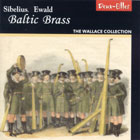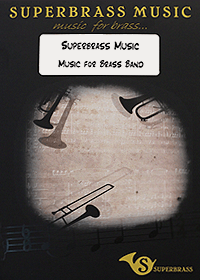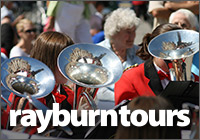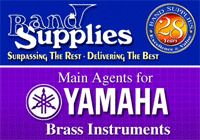 Baltic Brass
Baltic Brass
15-Aug-2002
The Wallace Collection
Music of Sibelius and Ewald
Deux-Elles Recordings: CD DXL 1042
Total Playing Time: 59 mins
John Wallace is a man who not only explores the outer limits of brass repertoire, but is also something of a musical archaeologist. Since the Wallace Collection was formed in 1986 his ensemble has covered repertoire that spans nearly six centuries, from the renaissance and baroque periods, right through to the modern and at times futuristic. He is a man with a very serious attitude towards his craft.
For this release he stretches back into antiquity somewhat and explores the brass ensemble repertoire of the late 19th and early 20th century, with works of Jean Sibelius and Victor Ewald. Although both were contempories – Sibelius was born in 1865 and died in 1957, whilst Ewald was born five years earlier but died in 1935; the two composers come from distinctly different musical hinterlands.
Brass ensembles were popular in Finland at the time of Sibelius's childhood with seven part "Torviseitsikolle" groups made up of cornets, sax horns and low Bb tuba, part of common musical culture. Sibelius was therefore aware of their capabilities and the two septet pieces featured on this release were written around the 1890's in the town of Loviisa, where the composer spent his summer holidays. It is believed by musical historians that "Tiera" itself was written in 1899, the year in which the composer wrote "Finlandia" and his first symphony – and as such represents a period when the composers output was at it's first significant peak.
Ewald in comparison was trained as a civil engineer, a career in which he gained considerable distinction, and whilst he was prominent composer of string quintets, his work was somewhat overshadowed by his contempories Borodin (himself a chemist by trade), Rimsky – Korsokov (a navy inspector) and Mussorgsky (a civil servant).
Brass ensembles in Russia were also popular and embraced the new modern brass instruments of Adolf Sax enthusiastically, with foreign performers such as Jules Levy and Jean Baptiste Arban travelling to the country as a mix of travelling salesmen cum cornet virtuosi. Historians believe that Ewald sought to standardise the instrumentation of brass quintets and wrote four in all. Only one was published in his lifetime, but due to the popularity of the genre, the first three of his output were resurrected and now form a core element of early brass output.
The Wallace Collection have sought to maintain this historical bearing by performing on period instruments - and the overall effect is stunning. Wallace himself plays on an 1862 Bb cornet and 1865 Eb soprano, which was made by the famous English makers, Higham's of Strangeways, Manchester. His fellow players perform on equally historic instrumentation with a further cornet from Courtois made in 1880, a rotary Althorn from the late 1890's, a class A compensating F tuba as well as Distin Levy 1870 cornet and 1880 Wolf Bb rotary tenor horn. The tone and timbres are nearly as good as anything you can hear today, whilst the intonation between instruments is excellent. You even have the added pleasure of hearing the valves and levers of the tuba being opened and closed as the player works like mad to keep up in the quicker sections.
The music itself is very much of its time and each of the three quintets from Ewald reveal a composer full of lyricism and romantic ideals, and brass band lovers will immediately recognise the Quintet Opus 5, which was arranged by Michael Hopkinson and used at the 2002 Regional Championships. In this it's original form however, it remains a much more satisfying work to listen to. The other quintets are lighter and less formal in their approach, whilst the two Sibelius works are beautifully crafted.
This is a very serious release – yet remains a CD that you will take great pleasure in listening to at length. Even the picture on the cover will intrigue – with a group entitled "The Russian Horn Band" dressed in top hats, minus trousers of any description and carrying instruments the size of rugby posts! The back picture shows some of the instruments used on the recording itself – making it an even more impressive achievement when you see them. The standard of playing is quite superb and the works themselves have a freshness and inventiveness that even today makes them sound relevant. This is a CD for both musicians and brass lovers to enjoy in full.
What's on this CD?
Petite Suite, Jean Sibelius
1. Preludium, 3.23
2. Andantino, 2.14
3. Menuetto, 1.36
4. Tiera, Jean Sibelius
Brass Quintet No.1 (Opus 5), Victor Ewald
5. Moderato, 4.26
6. Adagio, 3.28
7. Allegro Moderato, 3.32
Brass Quintet No. 2 (Opus 6), Victor Ewald
8. Allegro Risoluto, 6.38
9. Theme with Variations, 6.16
10. Allegro Vivace, 3.49
Brass Quintet No. 3 (Opus 7), Victor Ewald
11. Allegro, 6.47
12. Intermezzo, 6.06
13. Andante, 3.55
14. Vivo, 3.56









